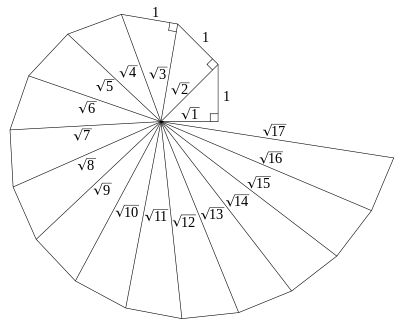Spiral of Theodorus

In geometry, the spiral of Theodorus (also called square root spiral, Einstein spiral or Pythagorean spiral)[1] is a spiral composed of contiguous right triangles. It was first constructed by Theodorus of Cyrene.
Construction
The spiral is started with an isosceles right triangle, with each leg having unit length. Another right triangle is formed, an automedian right triangle with one leg being the k hypotenuse of the prior triangle (with length √2) and the other leg having length of 1; the length of the hypotenuse of this second triangle is √3. The process then repeats; the i th triangle in the sequence is a right triangle with side lengths √i and 1, and with hypotenuse √i + 1. For example, the 16th triangle has sides measuring 4 (=√16), 1 and hypotenuse of √17
History and uses
Although all of Theodorus' work has been lost, Plato put Theodorus into his dialogue Theaetetus, which tells of his work. It is assumed that Theodorus had proved that all of the square roots of non-square integers from 3 to 17 are irrational by means of the Spiral of Theodorus.[2]
Plato does not attribute the irrationality of the square root of 2 to Theodorus, because it was well known before him. Theodorus and Theaetetus split the rational numbers and irrational numbers into different categories.[3]
Hypotenuse
Each of the triangles' hypotenuses hi gives the square root of the corresponding natural number, with h1 = √2.
Plato, tutored by Theodorus, questioned why Theodorus stopped at √17. The reason is commonly believed to be that the √17 hypotenuse belongs to the last triangle that does not overlap the figure.[4]
Overlapping
In 1958, Erich Teuffel proved that no two hypotenuses will ever coincide, regardless of how far the spiral is continued. Also, if the sides of unit length are extended into a line, they will never pass through any of the other vertices of the total figure.[4][5]
Extension

Theodorus stopped his spiral at the triangle with a hypotenuse of √17. If the spiral is continued to infinitely many triangles, many more interesting characteristics are found.
Growth rate
Angle
If φn is the angle of the nth triangle (or spiral segment), then:
Therefore, the growth of the angle φn of the next triangle n is:[1]
The sum of the angles of the first k triangles is called the total angle φ(k) for the kth triangle. It grows proportionally to the square root of k, with a bounded correction term c2:[1]
where
(![]() A105459).
A105459).

Radius
The growth of the radius of the spiral at a certain triangle n is
Archimedean spiral
The Spiral of Theodorus approximates the Archimedean spiral.[1] Just as the distance between two windings of the Archimedean spiral equals mathematical constant pi, as the number of spins of the spiral of Theodorus approaches infinity, the distance between two consecutive windings quickly approaches π.[6]
The following is a table showing of two windings of the spiral approaching pi:
| Winding No.: | Calculated average winding-distance | Accuracy of average winding-distance in comparison to π |
|---|---|---|
| 2 | 3.1592037 | 99.44255% |
| 3 | 3.1443455 | 99.91245% |
| 4 | 3.14428 | 99.91453% |
| 5 | 3.142395 | 99.97447% |
| → ∞ | → π | → 100% |
As shown, after only the fifth winding, the distance is a 99.97% accurate approximation to π.[1]
Continuous curve
The question of how to interpolate the discrete points of the spiral of Theodorus by a smooth curve was proposed and answered in (Davis 1993, pp. 37–38) by analogy with Euler's formula for the gamma function as an interpolant for the factorial function. Davis found the function
which was further studied by his student Leader[7] and by Iserles (in an appendix to (Davis 1993) ). An axiomatic characterization of this function is given in (Gronau 2004) as the unique function that satisfies the functional equation
the initial condition and monotonicity in both argument and modulus; alternative conditions and weakenings are also studied therein. An alternative derivation is given in (Heuvers, Moak & Boursaw 2000).
Some have suggested a different interpolant which connects the spiral and an alternative inner spiral, as in (Waldvogel 2009).
See also
References
- 1 2 3 4 5 . Also, this was used to visualize certain things in nature
Hahn, Harry K. "The Ordered Distribution of Natural Numbers on the Square Root Spiral". arXiv:0712.2184
 .
. - ↑ Nahin, Paul J. (1998), An Imaginary Tale: The Story of [the Square Root of Minus One], Princeton University Press, p. 33, ISBN 0-691-02795-1
- ↑ Plato; Dyde, Samuel Walters (1899), The Theaetetus of Plato, J. Maclehose, pp. 86–87.
- 1 2 Long, Kate. "A Lesson on The Root Spiral". Archived from the original on 4 April 2013. Retrieved 30 April 2008.
- ↑ Erich Teuffel, Eine Eigenschaft der Quadratwurzelschnecke, Math.-Phys. Semesterber. 6 (1958), pp. 148-152.
- ↑ Hahn, Harry K. (2008). "The distribution of natural numbers divisible by 2, 3, 5, 7, 11, 13, and 17 on the Square Root Spiral". arXiv:0801.4422
 .
. - ↑ Leader, J.J. The Generalized Theodorus Iteration (dissertation), 1990, Brown University
Further reading
- Davis, P. J. (1993), Spirals from Theodorus to Chaos
- Gronau, Detlef (March 2004), "The Spiral of Theodorus", The American Mathematical Monthly, Mathematical Association of America, 111 (3): 230–237, JSTOR 4145130, doi:10.2307/4145130
- Heuvers, J.; Moak, D. S.; Boursaw, B (2000), "The functional equation of the square root spiral", in T. M. Rassias, Functional Equations and Inequalities, pp. 111–117
- Waldvogel, Jörg (2009), Analytic Continuation of the Theodorus Spiral (PDF)